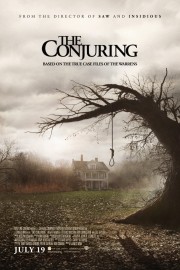The Conjuring
When people write about this era of horror filmmaking in future generations, I have a feeling a significant amount of time will be spent on the career of director James Wan. However, I don’t think it will be devoted to “Saw,” his 2004 breakthrough hit, and the series it inspired, so much as it will be the streak he’s on right now, which started with 2011’s hit paranormal thriller, “Insidious,” and now, “The Conjuring,” to say nothing of the promising September release of “Insidious: Chapter 2.” Here, it feels like we are just getting to know Wan as a filmmaker, and even though he’s on quite a roll, I think he’s just getting started.
One of the things I’m particularly pleased by in both “Insidious,” and now, “The Conjuring,” is the way Wan uses not just music, but also sound design, and even better, silence. In an age where most movies bombard us with a wall of sound, it’s great to see a filmmaker who appreciates what silence brings to the cinematic experience, and I can see Wan being a big fan of the silent era of horror, and understanding what made “Nosferatu” and “The Cabinet of Dr. Caligari” so impactful– the innovative visuals of those films, yes, but also the fact that we couldn’t hear the screams of terror the characters were emitting when faced with horrific experiences. The music could help guide our feelings, sure, but we feel as trapped as the characters do, as if there’s no escape. This is what Wan has accomplished in both “Insidious” and “The Conjuring,” and believe me, the emotional impact on a viewer is immediate, and visceral.
The stories help in that, and in “The Conjuring,” he has one based in real life. The main characters are Ed and Lorraine Warren, a couple who spent the ’60s and ’70s investigating the paranormal. Each of them bring something unique to the table, and they have such a strong emotional bond that they feel as though God had a reason to bring them together. They’ve investigated several cases together, and even have a room in their suburban house devoted to artifacts that are rife with demonic energy still; they have a priest come by and bless it every month, but they still make sure to lock it, and keep their daughter out of there. However, one particular case recently had some dangerous effects on Lorraine (played magnificently by Vera Farmiga), so that when the calls comes in to look into possession of a newly-purchased house by a blue-collar family (the parents of which are played by Lily Taylor and Ron Livingston, who do great work) and their five daughters, Ed (Patrick Wilson, also terrific) is more than a little hesitant to accept, especially when it seems as though exorcism is the only way to contain the evil.
As much as I appreciated “Saw,” and even its subsequent sequels, for their disturbing morality tales, I’m grateful that Wan has moved away from the “torture porn” genre it invented, and is working in traditional horror archetypes and ideas. Partially because of its setting and story, it’s easy to see “The Conjuring” as belonging with such ’70s classics as “The Exorcist,” “The Omen,” and “Susperia” in terms of its place in the genre as a whole. It doesn’t hurt that Wan, working from a great script by Chad and Carey Hayes, is more interested in goreless scares and giving us jumps that happen in plain sight, and depend on surprise mixed with suspense. As one person from the enthusiastic crowd I saw it with said (in effect) near the end, when such a moment occurred, “Oh, Hell no.” He was just saying what the rest of us were thinking. Wan did this type of thing beautifully in “Insidious,” but he takes it to a whole new level in “The Conjuring,” which makes me even more excited about “Insidious: Chapter 2” in a couple of months.
I really don’t want to spoil any of the scares in this one, because the surprise is part of the fun with this film, which is beautifully shot by John R. Leonetti and scored by Joseph Bishara, both of whom also worked on “Insidious.” I want to close this review by discussing what an exciting time it is to be a horror film fan, and no, I’m not kidding when I say that. Almost like clockwork, since 2002, we’ve seen most years deliver at least one great horror film to the upper echelon, from something as small as “The Signal” and “A Horrible Way to Die” to mid-level hits like “Insidious” and “Sinister” to instant classics like “The Ring,” “28 Days Later,” “The Cabin in the Woods,” “Drag Me to Hell,” and “Let the Right One In” (and its American version, “Let Me In”), among others I’m probably forgetting. It’s as though the fever of upping the ante in gore (and an absurd number of sequels) that resulted in endless franchises such as “Friday the 13th,” “I Know What You Did Last Summer,” and even “Saw” finally broke, and filmmakers looked back at the greats (your “Exorcists,” “Rosemary Babys,” and “Shinings”), and remembered what makes horror capable of real greatness. Add “The Conjuring” to that list of new classics, and James Wan as one of the filmmakers who will be a vital figure in the genre’s current resurgence in artistic purpose.










